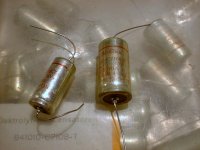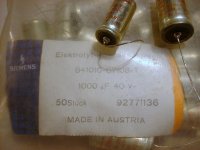Edward McFaddin Wynne wrote a pretty convincing thesis for his Master's degree at the University of North Texas: Determination of the Shelf Life of Aluminum Electrolytic Capacitors.
Give it a read. It's long but worth it. If you ever passed up a deal on nice-if-they-weren't-so-old electrolytics, you might want to skip it 😀
Determination of the shelf life of aluminum electrolytic capacitors. : UNT Digital Library
Cliffs: they're probably still good, and reforming them properly most definitely brings old cans back into specification. After DECADES of storage.
I did search, apologies if this is already known.
Give it a read. It's long but worth it. If you ever passed up a deal on nice-if-they-weren't-so-old electrolytics, you might want to skip it 😀
Determination of the shelf life of aluminum electrolytic capacitors. : UNT Digital Library
Cliffs: they're probably still good, and reforming them properly most definitely brings old cans back into specification. After DECADES of storage.
I did search, apologies if this is already known.
Science is great. Reforming is great, well proved. BUT electrolytics are water filled and sealed up with rubber or some other elastomer. Historic rubber is dirt. Heat from use deteriorates it faster, but oxygen will do the trick on it just sitting in a box. What elastomer they used at the factory matters. Knowing what elastomer is in your Ebay bargain box is something else. If I'm going to use a 25 year old electrolytic I'm going to make sure it is in a circuit that is well fused, and away from things that are hard to clean slime off of.
Last edited:
Some old capacitors can be reformed. Some can't: either they stay leaky, or their capacitance is low, or their ESR stays high.
Some capacitors which could have been reformed are blown up by people who are happy to take unnecessary risks by simply switching on.
Some capacitors which could have been reformed are blown up by people who are happy to take unnecessary risks by simply switching on.
down in my "workspace", I have an old McIntosh 250 I use for testing. It still has the original main bucket electrolytics. Someday I'll replace 'em, but right now I'm too lazy and the amplifier isn't really all that critical to my continued happiness. But still - I'm surprised the old girl keep chugging along.
I recently acquired a B&K 830 capacitance meter and I have been surprised to find that 90% plus of the electrolytics that I am replacing in vintage (30 years+) gear still measure within spec for capacitance, and usually quite close to nominal value. Perhaps the failure modes impact ESR or some other property beside C, or perhaps the materials used in the 60's & 70's were more durable.
There is no question there is higher quality elastomer available to designers in 1960's & 70's than was available to designers in 1940's-50's. Question 1, is did the designers use this, or was this cap a lowball product with red gum sealant.
Question 2, does the capacitor, however it measures at room temperature, have enough water in it to keep the plates separated chemically at working temperature. Question 3, however much water is in a stored cap, are the seals good enough to keep it in at operating temperature?
On the against side, the 70 capacitors I replaced 2010 in my 1968 organ were name brands. Replacing 4 cans raised the max volume 25 db and reactivated the dead percussion function. 2 axials made the string bass feature work. The other 64 just made the bass and treble much better. One electrolytic had been replaced in 97, by dealer service, the motor cap that burnt the insulation off the 120VAC wire to it. Replacing the can cap in my ST70 in 1970 at the behest of the McIntosh salesmen doubled the AC voltage out.
There are nasty pictures of cap explosions in 50's Leslie's and Hammonds on organforum.com. I would hope McIntosh used the longest life caps available, the prices they charge. I still can't afford even a used Mc tube amp.
Question 2, does the capacitor, however it measures at room temperature, have enough water in it to keep the plates separated chemically at working temperature. Question 3, however much water is in a stored cap, are the seals good enough to keep it in at operating temperature?
On the against side, the 70 capacitors I replaced 2010 in my 1968 organ were name brands. Replacing 4 cans raised the max volume 25 db and reactivated the dead percussion function. 2 axials made the string bass feature work. The other 64 just made the bass and treble much better. One electrolytic had been replaced in 97, by dealer service, the motor cap that burnt the insulation off the 120VAC wire to it. Replacing the can cap in my ST70 in 1970 at the behest of the McIntosh salesmen doubled the AC voltage out.
There are nasty pictures of cap explosions in 50's Leslie's and Hammonds on organforum.com. I would hope McIntosh used the longest life caps available, the prices they charge. I still can't afford even a used Mc tube amp.
Last edited:
I have heaps of Siemens Al Elko "Elytics" from the early seventies, and they are as good as new, and measure better than equivalent modern parts (they are much larger though).
They do not even need the slightest reforming: more than 37 years after they were manufactured, they can take instantly their full working voltage.
On close examination, they look like as if they had been manufactured yesterday, the rubber seal is perfectly elastic, smooth and shiny.
I expect them to be in the same condition in another 37 years.
They do not even need the slightest reforming: more than 37 years after they were manufactured, they can take instantly their full working voltage.
On close examination, they look like as if they had been manufactured yesterday, the rubber seal is perfectly elastic, smooth and shiny.
I expect them to be in the same condition in another 37 years.
Attachments
Excellent thesis article....this not only proves his theory but does a nice job of explaining exactly what the aging process does to the caps and how reforming seems to work. These things have always been a mystery to me until now. I am still a neophyte when it comes to electronics and found this article to be immensely helpful in understanding electrolytic capacitors.
- Status
- Not open for further replies.
- Home
- Design & Build
- Parts
- Old Electrolytic Capacitors Still Good . . . Genuine Science


